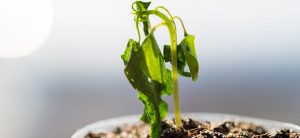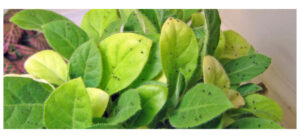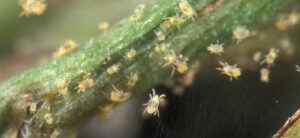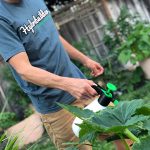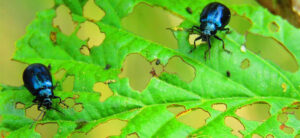
Damping off disease can stop your growth before it even really has a chance to get started. It kills ruthlessly, attacking just about any variety of plant seedling.
Though it most commonly affects plants grown indoors, this disease strikes indiscriminately in any environment.
No plant is immune, either. But if you think your plants might be suffering from this frustrating condition, don't stress too much.
There are some simple steps you can take to attempt to restore your grow and still salvage a successful cycle. We'll cover how to prevent it in the first place, along with our top tips for treating it.
But before we get into all that, we need to answer the question, "what is damping off disease?".
What Is Damping Off Disease?
Damping off disease is a general, somewhat broad term used for the sudden death of new plant seedlings.
It can be caused by a wide array of fungal diseases, including several kinds of root rot (like Phytophthora and Pythium) diseases as well as molds (including gray mold, white mold, Botrytis, or Sclerotinia). One of the most common culprits is actually powdery mildew.
This disease can affect many kinds of vegetables and flowers. Often, it will kill an entire tray of seedlings and can lead to secondary diseases, too, such as crown rot.
What Are The Symptoms Of Damping Off Disease?
Some gardeners delay addressing cases of this disease simply because they aren’t sure that it’s damping off causing them grief. There are several tell-tale symptoms to watch out for.
If your seedlings seem to be doing well, growing healthy and strong, and seemingly overnight they are withering and dying, it’s probably damping off (barring some strange weather or climatic event, of course).
Damping off affects stems of seedlings, both where the stem is visible above the soil line and where it is not (underground).
The easiest way to tell is if your seedlings take a drastic turn for seemingly no reason and suddenly start to wither away. Some may look as though they are pinched or collapsed.
Sometimes, there is a gradual discoloration - but in other plants, the changes are abrupt and happen all of a sudden.
There are other times, though, when damping off is even less noticeable. For example, it can cause your seedlings to appear as though they are wilting, even if they are getting plenty of water.
This may lead you to suspect overwatering, but that proves to not be the case either.
Damping off is even linked to poor germination, so if your seedlings fail to germinate at all, it could be damping off to blame.
How to Prevent Damping Off
An ounce of prevention is worth a pound of cure, so we want to share some of the easiest, more sure-fire ways to prevent damping off disease from infiltrating your grow room or garden in the first place.
For the most part, these are things every grower should be doing anyway. It comes down to good growing hygiene and practices.
Sanitize All Gardening Pots
Between uses, make sure you sanitize your gardening pots. To some people, this might sound a bit over the top, but if you’re worried about damping off, it’s absolutely necessary.
If your pots aren’t sterilized, there’s a good chance that they’ll harbor dangerous fungal spores that can wreak havoc on your gardening plans later on.
To sterilize, wash the pots in a mixture of one part bleach to ten parts water. Don’t forget to sanitize your other gardening equipment, too.
For best results, though, use a special grow room cleaner/disinfectant. These are more effective at eliminating the many pathogens that growers face.
You want to make sure all pots, tools, and other equipment is clean and ready to go before you use it on your new plants.
Use the Right Soil
When you’re starting your seeds indoors, make sure you use a good organic potting soil. Don’t reuse soil from the garden or attempt to plant right into the ground.
This can harbor diseases and even pests. The mixture should be both light and fast-draining to prevent it from becoming overly waterlogged.
Our favorites are:
- Fox Farm Ocean Forest
- Mother Earth Groundswell
- Fox Farm Light Warrior Soilless Mix
- Botanicare ReadyGro Aeration Formula
Plant at the Right Depth
When you plant seeds, make sure you are following the instructions for that plant type. Some plants like to be planted very deep, but others just need a dusting of soil.
Planting seeds too deep will make them have to work hard to germinate. When you seed, make sure you are doing so thinly to avoid crowding.
This can lead to humid conditions that are favorable for damping off. You might have to thin seedlings later on, too, to make sure you are following proper spacing.
If germinating in a paper towel and then moving to a soil, you typically want to plant your seeds a half inch deep at most.
Avoid Crowding Seedlings
Seedlings shouldn't be planted right on top of each other.
Make sure there is plenty of room between the seedlings for proper air circulation.
Both mold and fungal disease love crowded, damp conditions with poor circulation.
Avoid Feeding Too Early
Whatever you do, don’t fertilize until several true leaves have developed.
Many potting mixes already contain slow-release fertilizers, so you don’t need to fertilize until your plants are much larger.
Fertilizers can encourage the spread of fungal disease. But, they also are just too strong for young plants. You shouldn't be feeding plant nutrients until your babies are at least 6" out of the ground, with true leaves well developed. Otherwise, you can burn them.
Practice Good Watering Hygiene
When you water your seedlings, be careful not to get water all over the foliage. Keeping the leaves and stem of the plant dry makes you less likely to suffer from various fungal diseases.
Try to water in the morning, instead of the evening, so that the plants have plenty of time to dry off before the sun goes down or your grow lights turn off, too.
Don’t let your plants sit in water for long periods of time. Not only can it lead to damping off, but it can cause other fungal problems, including general root rot, too. You should have an efficient, clean way of removing runoff from your saucers or trays.
Speed Up Germination With Heat & Light
Seedlings and seeds both need light, moisture, and heat to germinate and grow.
The quicker you can get your plants growing, the less likely damping off will be - remember, it only affects seedlings.
Once you get your plants past this sensitive stage, you’ll usually be in the clear.
How to Get Rid of Damping Off Disease On Your Plants

Unfortunately, curing damping-off once it’s arrived is very difficult. The seedlings will die so fast that there’s usually nothing you can do to save them in time.
Avoiding the disease altogether by following the steps mentioned above is your very best line of defense.
However, if you’re one of the “lucky” few who experiences damping off as a more gradual onset of symptoms, you may have a few steps you can take to reverse its effects.
Cull Any Affected Plants
It might break your heart, but you may need to cull your supply of seedlings in order to protect what’s left.
Damping off spreads quickly, and often, it will jump to nearby plants with little warning that it’s spreading.
If you see plants that are clearly affected by damping off, remove them as soon as possible.
Repot Your Seedlings
Get your seedlings into a new container. Even if they were growing directly in the ground or a raised bed before, it might be necessary to temporarily relocate them to a pot.
When you repot, use sterile potting mix instead of the soil from your garden. Garden soil, no matter how harmless it looks, can harbor dangerous molds and funguses that are linked to damping off.
Make sure your pot is clean and sterile, too, because even the smallest amount of soil in a plant pot is enough to harbor fungal spores.
Use Hydrogen Peroxide
One of the most effective ways to beat damping off disease is with good old hydrogen peroxide.
Take a dropper with about 1mL of 3% strength hydrogen peroxide and drop it into the soil of each of the affected plants.
Hopefully, it is able to kill the fungus and get your plants back to the condition they were once in.
Organocide Plant Doctor Systemic Fungicide
There are few fungicides that can bear fruitful results in combating damping off disease. But, if there is one we had to recommend, it would be Organocide Plant Doctor.
This is a broad use, systemic fungicide. It works its way through the entire plant to flush out any fungi, bacteria, or pathogens that can harm your grow.
It is highly concentrated, and if anything can remedy damping off disease, this is it.
Final Thoughts On Damping Off
One of the best lines of defense against damping off disease is setting up the ideal conditions for seeds and clones.
Consider the optimal temperature, humidity, soil, and other conditions for the plants you are growing, and make sure you adhere to those guidelines.
Give your seedlings at least 18 hours of light each day - and ideally some heat - to keep them warm while they germinate, too.
If you do things correctly, by the book, you shouldn't have to deal with this frustrating disease at any point.
To learn more about the common grow room pests and diseases, check out our complete guide!





